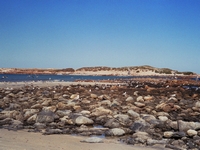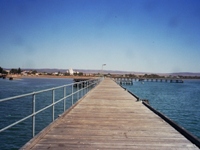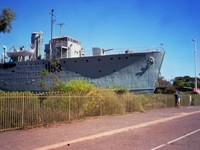Australia So Much to See
The dry eastern coastline of the Eyre Peninsula in South Australia
The Eastern Eyre Peninsula
At Port Lincoln it was the annual Tunarama Festival weekend and we drove through the town and out
past waiting crowds along the roadside, just ahead of the main parade, feeling very special as they waved.
On the north
side of Port Lincoln at North Shields we saw the greatest devastation from the fire. The caravan park on the east side of the
road was burnt out right to the beach, and in streets where some houses were burnt a few still stood amongst the ruins. This was where the greatest loss of lives occurred.
80,000 hectares of land was burned out, 73 houses, as well as sheds,
caravans, buses, boats and a shop. Nine people died in the bushfires, while more than 100 people were injured. Around
5,000 kilometres of fencing was lost, and livestock that couldn’t be moved to agistment were shot due to lack of water, as the pipeline
bringing water into the region was damaged by the fire.
Some farmers were already commencing replacing fences on their
bare paddocks. I could not intrude and photograph these scenes. The only photo I took shows the ground burnt bare, with
scorched trees and blackened hills.
We could see where fingers of fire had rushed across paddocks with the strong winds. Speaking to locals, they told us of a very hot day with unpredictable and swirling strong winds.
Further up the coast, locals
told us that on the Eyre at times of high fire danger the electricity system is shut down. Considering the number of fires in
At beautiful
At Lipson Cove there is a small island where terns nest. Terns were feeding their young on the beach near where we had a swim while the birds noisily protested at our dipping in their fishing ground. We had the Cove to ourselves that night, but for these noisy terns. A truly delightful spot for nature lovers.

It was a warm day at Cowell, where the boat launching ramp and dock has been constructed utilising old tyres. Again the bay
is almost fully enclosed, and there are fish farms of yellow tail, king fish, snapper and tommy ruff (what we call herring), but we
were told these farms are not viable. Oysters are now farmed.
The area receives and average of 8” of rain per annum;
less in recent years. Locals told us how hot winds from the
Mangroves
lined the coast and the water nearby was murky, so going for a swimming was not an attractive idea. There was a short mangrove
boardwalk near the jetty.
Nephrite jade was discovered near Cowell in 1966, and has only been effectively mined since
1976. This high quality jade is mined on private property with no public access. The Cowell jade deposits, found occurring
in an area confined to nine square kilometres, are recognised as being amongst oldest and largest in the world. The majority of the
jade from Cowell is traditional green. A small portion is black and this commands the highest price owing to its rarity and ability
to take a high polish. Associated with the jade are deposits of ornamental marble and carving quality talc.
We passed Iron Duke,
angular and with lines of colour indicating slag heaps rather than the shape of the original mountain. This was similar to Iron
Knob, but Iron Duke is still being actively mined. Mining commenced here in 1990.
The first ship built at the Whyalla's
BHP shipyards in 1941 - HMAS Whyalla – has been permanently landlocked two kilometres from the sea and is part of the
At
dusk a full moon rose over the orange ridge to the east of us at our roadside stop north of Whyalla.



The following history is as shown on a sign at Lipson Cove.
Named after Captain Thomas Lipson R.N. in 1840. Lipson was Australia's first Harbour Master and also Collector of Customs.
John Tennant, originally from Dumfreisshire, Scotland, is believed to be the first person to permanently settle in the hills behind Lipson Cove in 1846.
Copper was discovered in 1849 south west of the jetty and mined for three years. An old gold prospector, locally known as Wallaby Sam, lived in a cave though to be one of the copper mine entrances.
Remains of "Three Sisters", a 15 ton ketch which broke up in a storm in 1889 is occasionally exposed from under the beach sand.
Edward Swaffer began shearing sheep at Lipson Cove in 1875. The ruins of the shearing shed, kitchen and dips are visible left of the causeway leading to the jetty.
The jetty was built around 1882, closed in 1935 and dismantled in 1949.
Crossing the Blackwood River, the current all weather bridge replaced the old one which use to go under in winter. Camping is
allowed at the junction of the Boyup Brook-Arthur Road and Trigwells Bridge Road. There is good unserviced camping at Eulin
Crossing upstream of Trigwells Bridge accessed via Eulin Crossing Road.
The 300 kilometre long Blackwood River begins
at the junction of Arthur River and Balgarup River near Dead Horse Swamp, which is not accessible by road, around ten kilometres direct
line from Trigwells Bridge. The river has a total catchment area of 28,100 square kilometres, much of this in the wheatbelt,
and reaches the Hardy Inlet at Augusta.